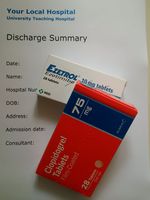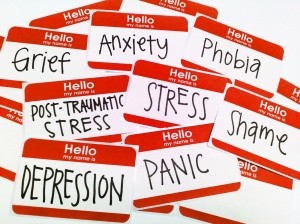Discharge Management for Traumatic Brain Injury: Difference between revisions
(text, format.) |
(text, media) |
||
| Line 5: | Line 5: | ||
</div><div align="justify"> | </div><div align="justify"> | ||
== General Principles of Good Practice for Discharge == | == General Principles of Good Practice for Discharge == | ||
[[File:Mock_Discharge_Form.jpg|right|frameless|200x200px]]Discharge planning should involve, from the outset, the patient and their family/carers, and the rights and wishes of the patient should be listened to and respected. | [[File:Mock_Discharge_Form.jpg|right|frameless|200x200px]]Good discharge planning can make all the difference to the clients ongoing well being. | ||
Discharge planning should involve, from the outset, the patient and their family/carers, and the rights and wishes of the patient should be listened to and respected. | |||
If possible, it is considered useful that the discharge occur in the morning, providing the afternoon and evening hours for the individual to settle into their new environment before going to sleep. Earlier in the week is also better than a friday as many services me be out over the weekend. | If possible, it is considered useful that the discharge occur in the morning, providing the afternoon and evening hours for the individual to settle into their new environment before going to sleep. Earlier in the week is also better than a friday as many services me be out over the weekend. | ||
| Line 32: | Line 34: | ||
* Ongoing rehabilitation requirements | * Ongoing rehabilitation requirements | ||
* Any special dietary requirements (eg. soft diet, or thickened fluids) if the patient has problems with swallowing | * Any special dietary requirements (eg. soft diet, or thickened fluids) if the patient has problems with swallowing | ||
* Contact details for key professionals | * Contact details for key professionals and all health providers involved when discharged | ||
* If appropriate, details on how to manage incontinence/urinary catheter | * If appropriate, details on how to manage incontinence/urinary catheter | ||
NB It is important to check with client and carers/family they understand the process and feel comfortable with the arrangements. | |||
== Return to Work == | == Return to Work == | ||
People who have suffered mild to moderate TBI may be able to return to the work they were involved in before their brain injury. Return to work is an important measure of integration into the community. One author reports that individuals with brain injury who fail to return to work have a lowered subjective wellbeing when compared to those who succeed in returning to work<ref>Cicerone, K.D. Cognitive Rehabilitation for traumatic brain injury and stroke: Updated review of the literature from 1998 through 2002 with recommendations for clinical practice. America: Archives of Physical medicine and rehabilitation, 2000;92,(4),1596-1615.</ref>. | [[File:Disabled workers.jpg|right|frameless]]People who have suffered mild to moderate TBI may be able to return to the work they were involved in before their brain injury. Return to work is an important measure of integration into the community. One author reports that individuals with brain injury who fail to return to work have a lowered subjective wellbeing when compared to those who succeed in returning to work<ref>Cicerone, K.D. Cognitive Rehabilitation for traumatic brain injury and stroke: Updated review of the literature from 1998 through 2002 with recommendations for clinical practice. America: Archives of Physical medicine and rehabilitation, 2000;92,(4),1596-1615.</ref>. | ||
Studies show that only 30% of people with moderate TBI and 80% of people with mild TBI successfully return to work<ref>Vuadens,P. & Arnold,P & Bellmann,A. Return to work after a traumatic brain injury- Vocational Rehabilitation. Pari: Springer Paris; 2006.</ref>, | Studies show that only 30% of people with moderate TBI and 80% of people with mild TBI successfully return to work<ref>Vuadens,P. & Arnold,P & Bellmann,A. Return to work after a traumatic brain injury- Vocational Rehabilitation. Pari: Springer Paris; 2006.</ref>, The image shows a workplace for the disabled in Vietnam. | ||
==== Barriers to returning to work: ==== | ==== Barriers to returning to work: ==== | ||
| Line 49: | Line 52: | ||
== Sequelae which commonly occur late in TBI, after Discharge == | == Sequelae which commonly occur late in TBI, after Discharge == | ||
NOTE: for more information see [[Medical Complications in Traumatic Brain Injury|Medical Complications in TBI]] page. | |||
Below a few of the sequelae are listed | Below a few of the sequelae are listed | ||
* [[Heterotopic Ossification]] This build up of new bone at the joint has been found to occur in between 10% and 20% of patients with moderate to severe TBI<ref>Hsu JE, Keenan MA. Current review of heterotopic ossification. UPOJ 2010; 20: 126-130</ref>. The most common sites is the hip, followed by the elbow<ref>Mavrogenis AF, Soucacos PN, Papagelopoulos PJ. Heterotopic Ossification Revisited. Orthopedics. 2011Jan;34(3):177</ref> | * [[Heterotopic Ossification]] This build up of new bone at the joint has been found to occur in between 10% and 20% of patients with moderate to severe TBI<ref>Hsu JE, Keenan MA. Current review of heterotopic ossification. UPOJ 2010; 20: 126-130</ref>. The most common sites is the hip, followed by the elbow<ref>Mavrogenis AF, Soucacos PN, Papagelopoulos PJ. Heterotopic Ossification Revisited. Orthopedics. 2011Jan;34(3):177</ref> | ||
* Post Traumatic seizures (which, in turn, causes further damage to the brain | * Post Traumatic seizures (which, in turn, causes further damage to the brain[[File:Mental health thumbnail.jpg|right|frameless]] | ||
<div align="justify"> | <div align="justify"> | ||
<div align="justify"> | <div align="justify"> | ||
| Line 59: | Line 62: | ||
* Nutritional Deficits | * Nutritional Deficits | ||
* Degenerative Brain Diseases and Dementia | * Degenerative Brain Diseases and Dementia | ||
* Mental Health Problems | |||
* Pituitary Dysfunction. Pituitary dysfunction, leading to neuroendocrine dysfunction, is a recognised but potentially underdiagnosed complication of TBI[1][2]. It is often labelled Post-traumatic hypopituitrism. This can result in "neurobehavioural sequelae" including concentration difficulties, fatigue, anxiety and depression[3]. One study[4] specifically looked at the time of onset of pituitary dysfunction, and concluded: "The risk of developing endocrine dysfunction after TBI increased during the entire 5-year follow-up period." | * Pituitary Dysfunction. Pituitary dysfunction, leading to neuroendocrine dysfunction, is a recognised but potentially underdiagnosed complication of TBI[1][2]. It is often labelled Post-traumatic hypopituitrism. This can result in "neurobehavioural sequelae" including concentration difficulties, fatigue, anxiety and depression[3]. One study[4] specifically looked at the time of onset of pituitary dysfunction, and concluded: "The risk of developing endocrine dysfunction after TBI increased during the entire 5-year follow-up period." | ||
<div align="justify"> | <div align="justify"> | ||
Revision as of 07:38, 19 October 2019
Original Editor - Wendy Walker
Top Contributors - Wendy Walker, Naomi O'Reilly, Lucinda hampton, Kim Jackson, Rachael Lowe, Admin, Jess Bell, Tarina van der Stockt, Simisola Ajeyalemi, Uchechukwu Chukwuemeka and Rucha Gadgil
General Principles of Good Practice for Discharge[edit | edit source]
Good discharge planning can make all the difference to the clients ongoing well being.Discharge planning should involve, from the outset, the patient and their family/carers, and the rights and wishes of the patient should be listened to and respected.
If possible, it is considered useful that the discharge occur in the morning, providing the afternoon and evening hours for the individual to settle into their new environment before going to sleep. Earlier in the week is also better than a friday as many services me be out over the weekend.
For patients returning home, adaptations may need to be provided prior to discharge. The video below gives a brief look at the process.
[1]Planning for Discharge[edit | edit source]
In many hospitals, there is a named professional who has overall responsibility for discharge planning.
A formal discharge meeting should be arranged, involving (but not limited to)
- patient
- hospital nursing staff
- medical social worker
- rehabilitation staff (including physiotherapist, occupational therapist, speech and language therapist if relevant)
- social services staff
- close family members and carers (if appropriate)
In some cases the person may be able to go on a trial visit home for a day and/or overnight before actually being discharged.
Information Provided on Discharge[edit | edit source]
The hospital should provide information on:
- Symptoms of complications that could require urgent treatment
- Activities to avoid, and for how long (eg. driving)
- Prescriptions and medications
- Cognitive changes which may be expected, and suggestions on their management
- Ongoing rehabilitation requirements
- Any special dietary requirements (eg. soft diet, or thickened fluids) if the patient has problems with swallowing
- Contact details for key professionals and all health providers involved when discharged
- If appropriate, details on how to manage incontinence/urinary catheter
NB It is important to check with client and carers/family they understand the process and feel comfortable with the arrangements.
Return to Work[edit | edit source]
People who have suffered mild to moderate TBI may be able to return to the work they were involved in before their brain injury. Return to work is an important measure of integration into the community. One author reports that individuals with brain injury who fail to return to work have a lowered subjective wellbeing when compared to those who succeed in returning to work[2].Studies show that only 30% of people with moderate TBI and 80% of people with mild TBI successfully return to work[3], The image shows a workplace for the disabled in Vietnam.
Barriers to returning to work:[edit | edit source]
- Cognitive impairment
- Loss of motivation
- Fatigue
- Lack of support provided in the work environment
- Inadequate communication between medical professionals and the employer/manager with the result that the employer does not know how to support the person with TBI[4]
Sequelae which commonly occur late in TBI, after Discharge[edit | edit source]
NOTE: for more information see Medical Complications in TBI page.
Below a few of the sequelae are listed
- Heterotopic Ossification This build up of new bone at the joint has been found to occur in between 10% and 20% of patients with moderate to severe TBI[5]. The most common sites is the hip, followed by the elbow[6]
- Post Traumatic seizures (which, in turn, causes further damage to the brain
- Bladder Bowel Dysfunction and Genitourinary Complications
- Nutritional Deficits
- Degenerative Brain Diseases and Dementia
- Mental Health Problems
- Pituitary Dysfunction. Pituitary dysfunction, leading to neuroendocrine dysfunction, is a recognised but potentially underdiagnosed complication of TBI[1][2]. It is often labelled Post-traumatic hypopituitrism. This can result in "neurobehavioural sequelae" including concentration difficulties, fatigue, anxiety and depression[3]. One study[4] specifically looked at the time of onset of pituitary dysfunction, and concluded: "The risk of developing endocrine dysfunction after TBI increased during the entire 5-year follow-up period."
Resources[edit | edit source]
Headway have useful information about returning to work after brain injury.
The document Brain Injury; a guide for employers by Headway has detailed information on the topic.
Headway also produce information on Self Employment after Brain Injury and Voluntary Work after Brain Injury.
References[edit | edit source]
References will automatically be added here, see adding references tutorial.
- ↑ Summer Foundation Hospital Discharge Part E – NDIS Planning Available from: https://www.youtube.com/watch?v=4iVH4gu3J2c (last accessed 19.10.2019)
- ↑ Cicerone, K.D. Cognitive Rehabilitation for traumatic brain injury and stroke: Updated review of the literature from 1998 through 2002 with recommendations for clinical practice. America: Archives of Physical medicine and rehabilitation, 2000;92,(4),1596-1615.
- ↑ Vuadens,P. & Arnold,P & Bellmann,A. Return to work after a traumatic brain injury- Vocational Rehabilitation. Pari: Springer Paris; 2006.
- ↑ Law, M., Baum, C.M. & Dunn, W. Occupational performance assessment. In C.H Christiansen, C.M Baum & J. Bass- Haugen (Eds.). Occupational therapy: performance, participation & well being (3rd edition). Thorofare New Jersey: Slack Incorporated; 2005.
- ↑ Hsu JE, Keenan MA. Current review of heterotopic ossification. UPOJ 2010; 20: 126-130
- ↑ Mavrogenis AF, Soucacos PN, Papagelopoulos PJ. Heterotopic Ossification Revisited. Orthopedics. 2011Jan;34(3):177









